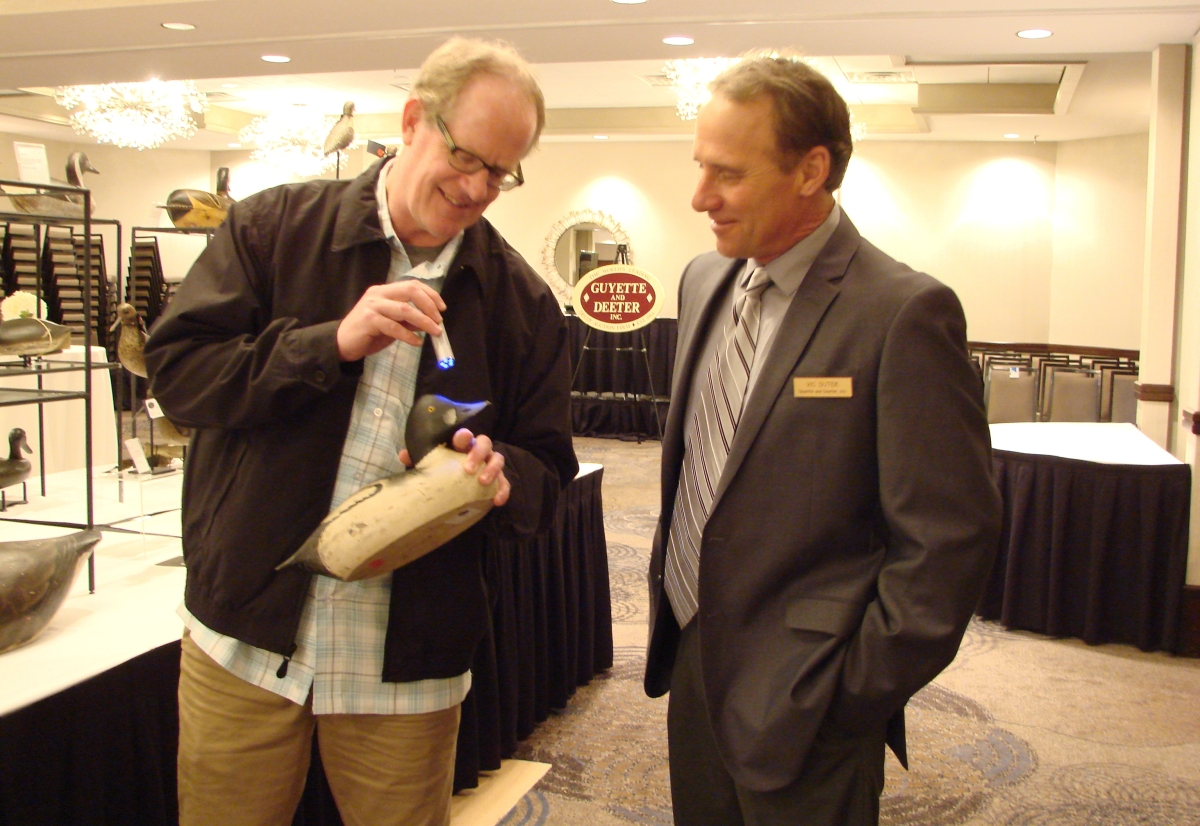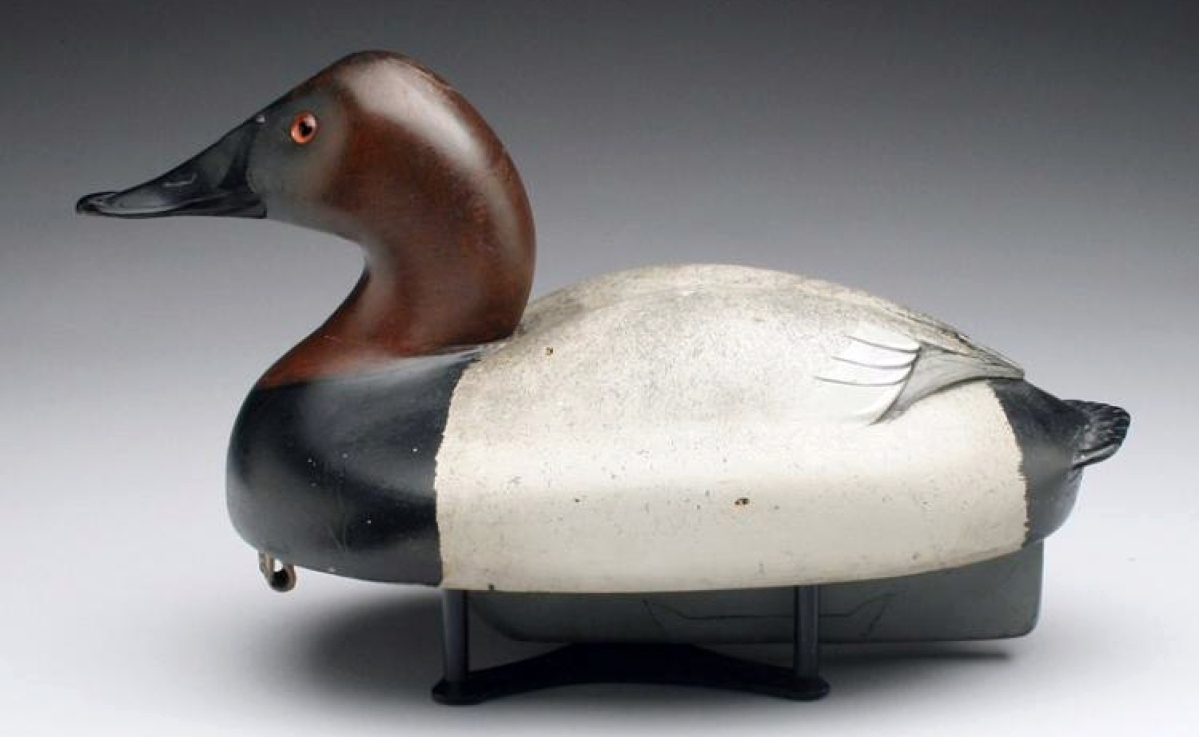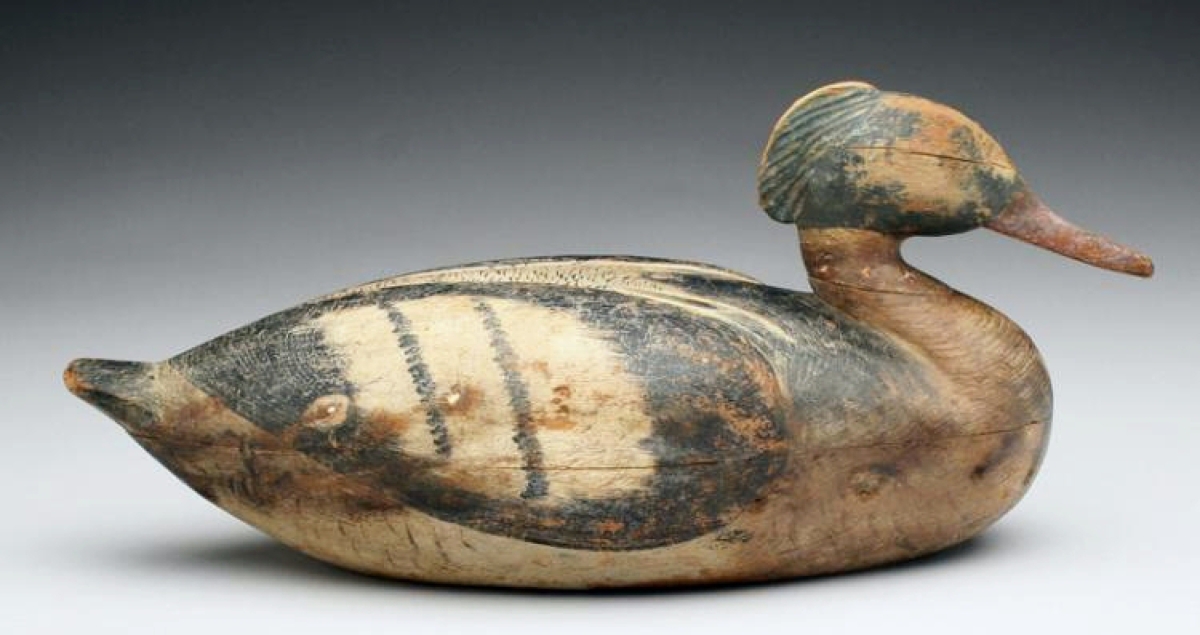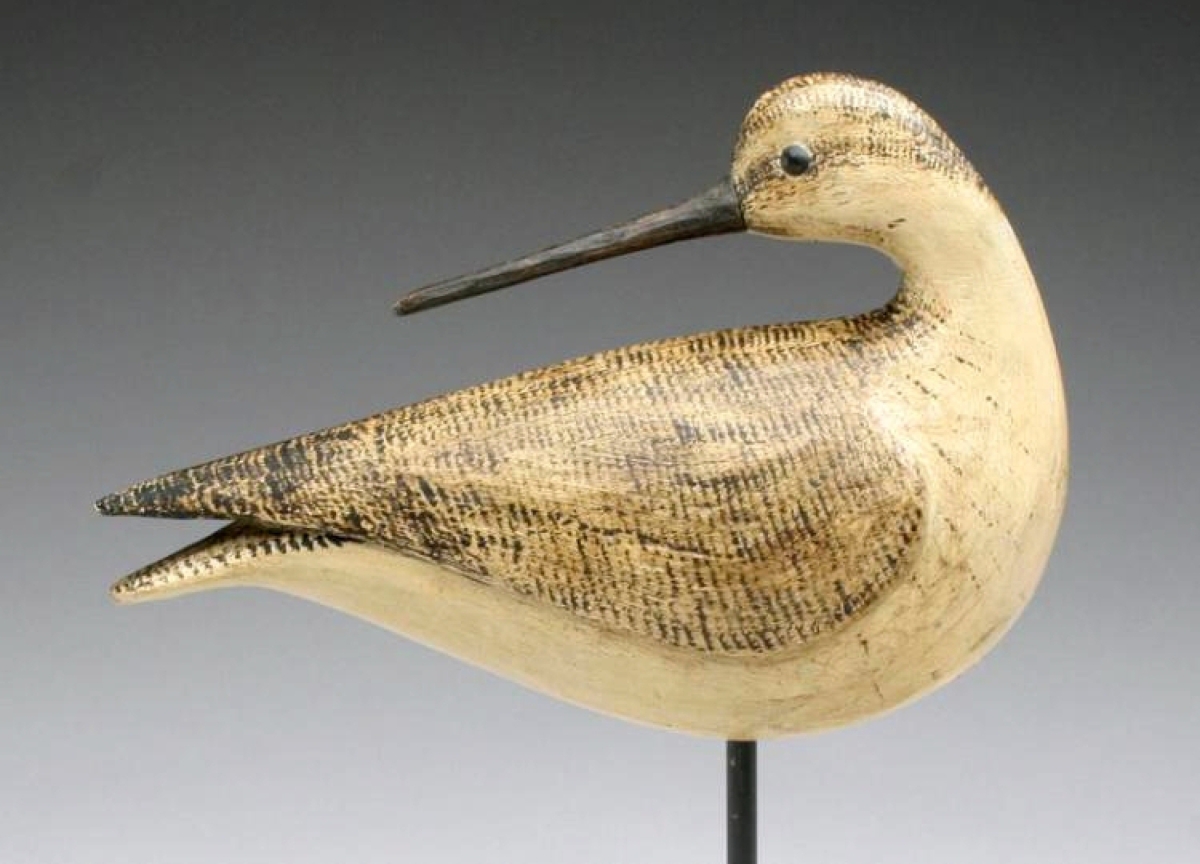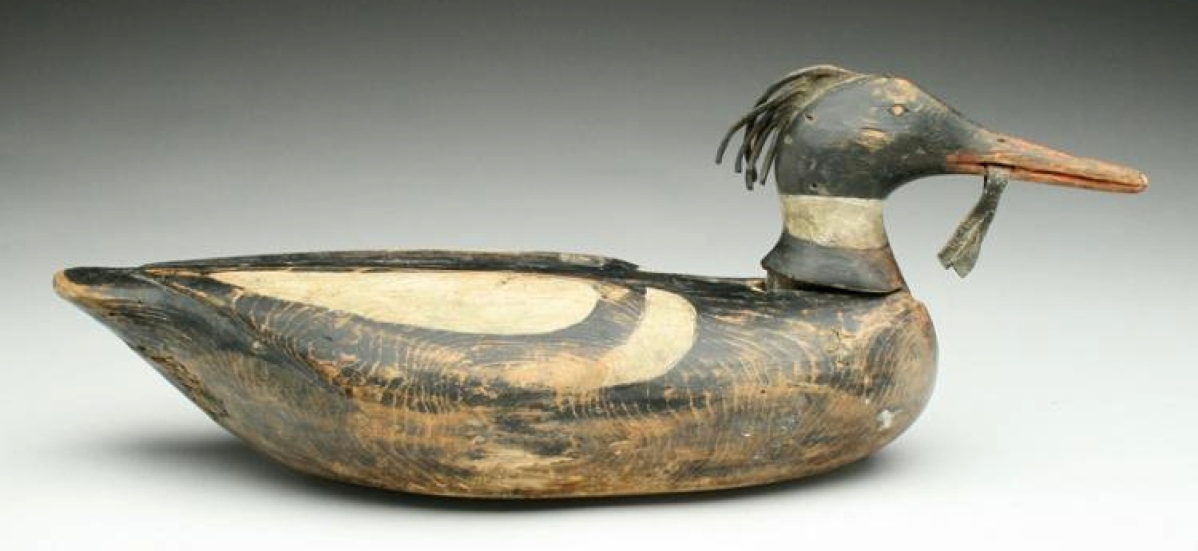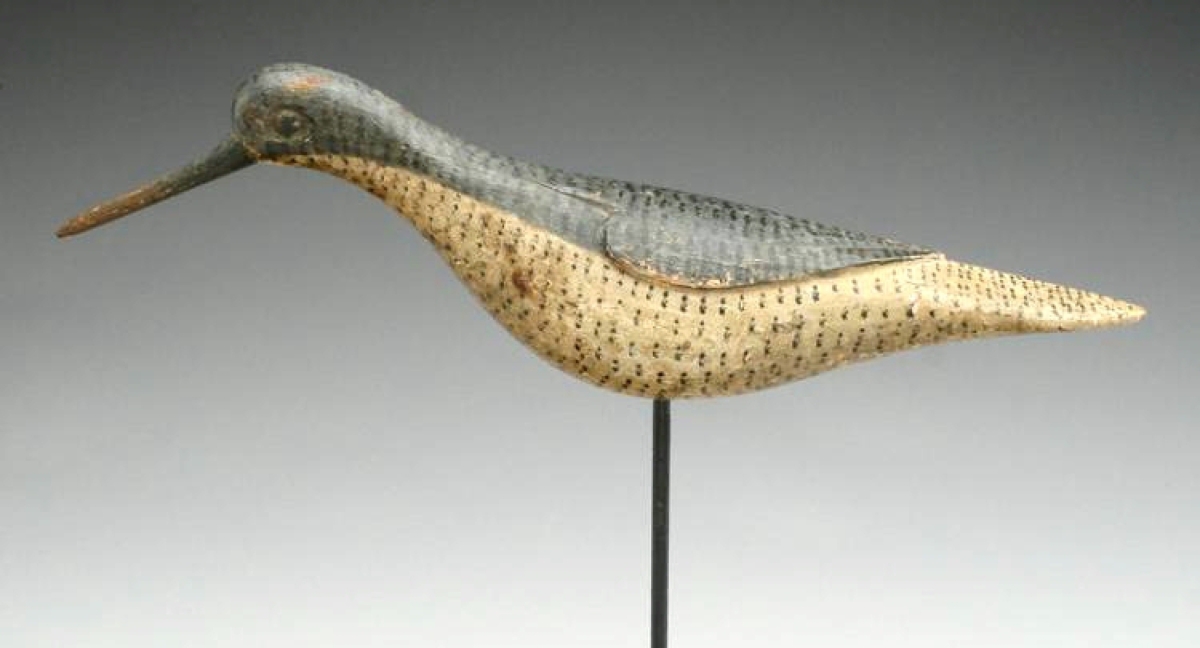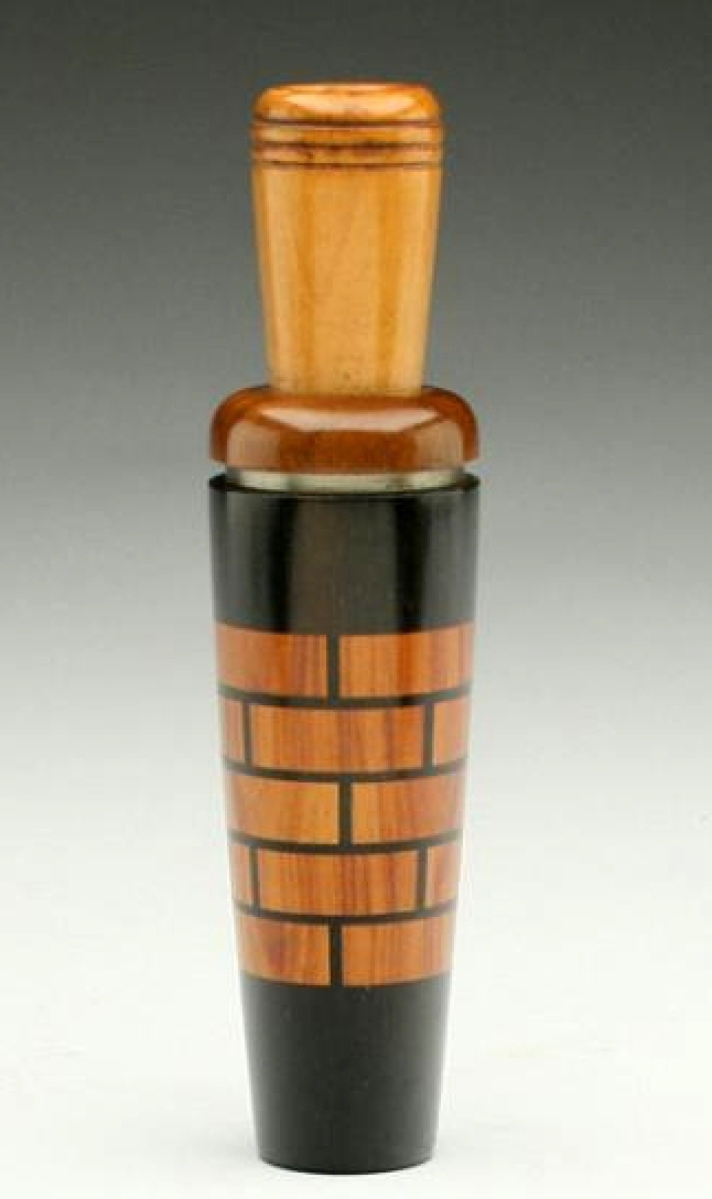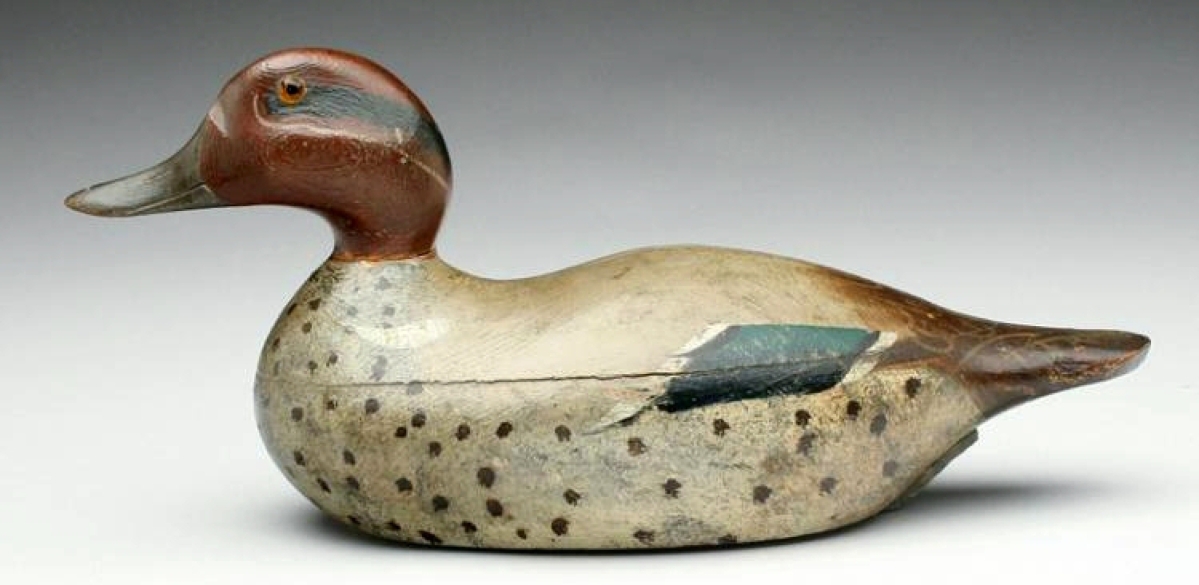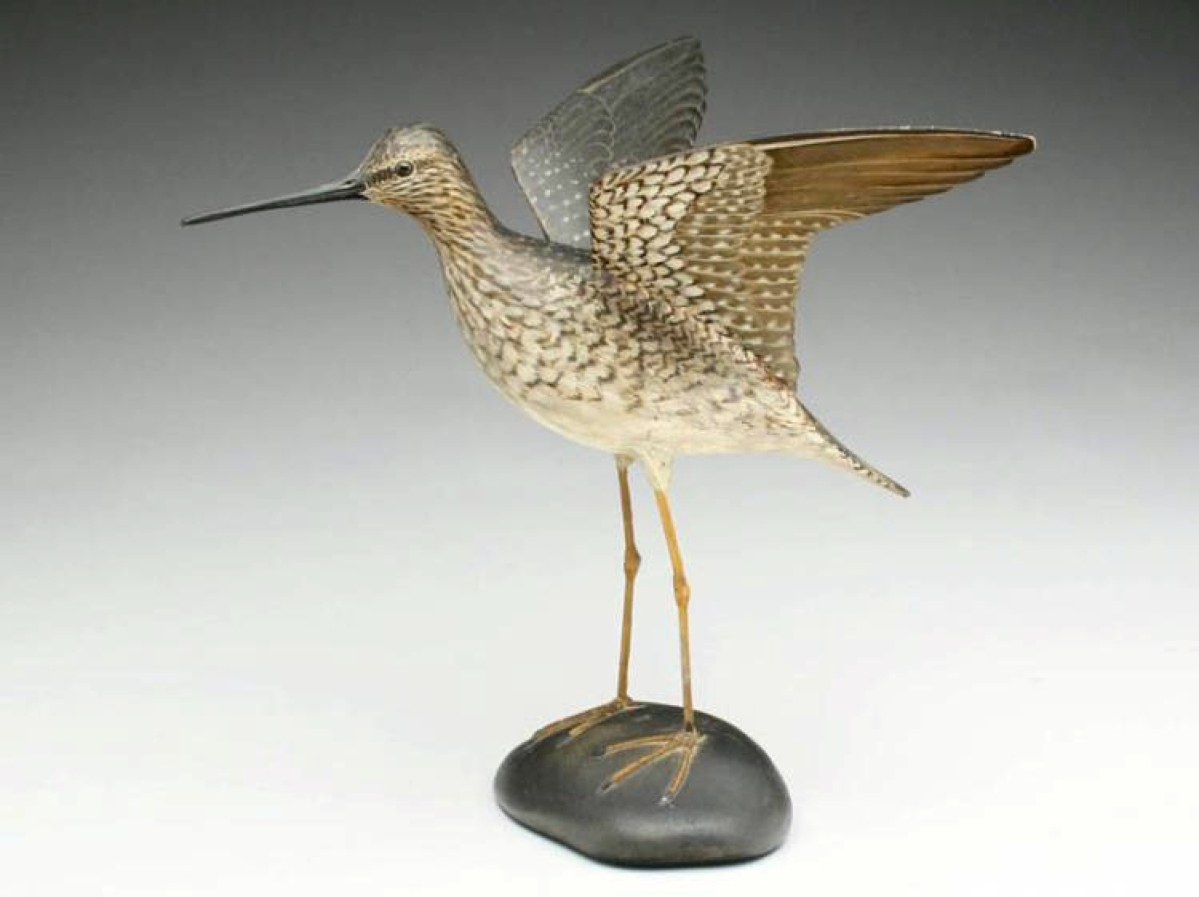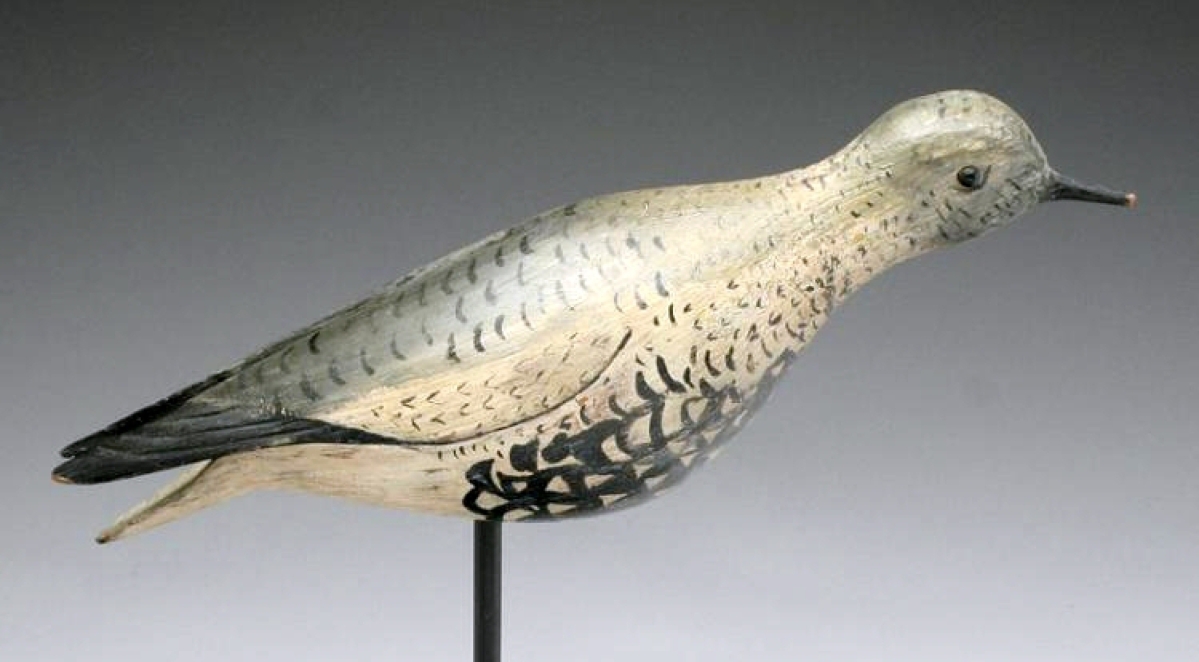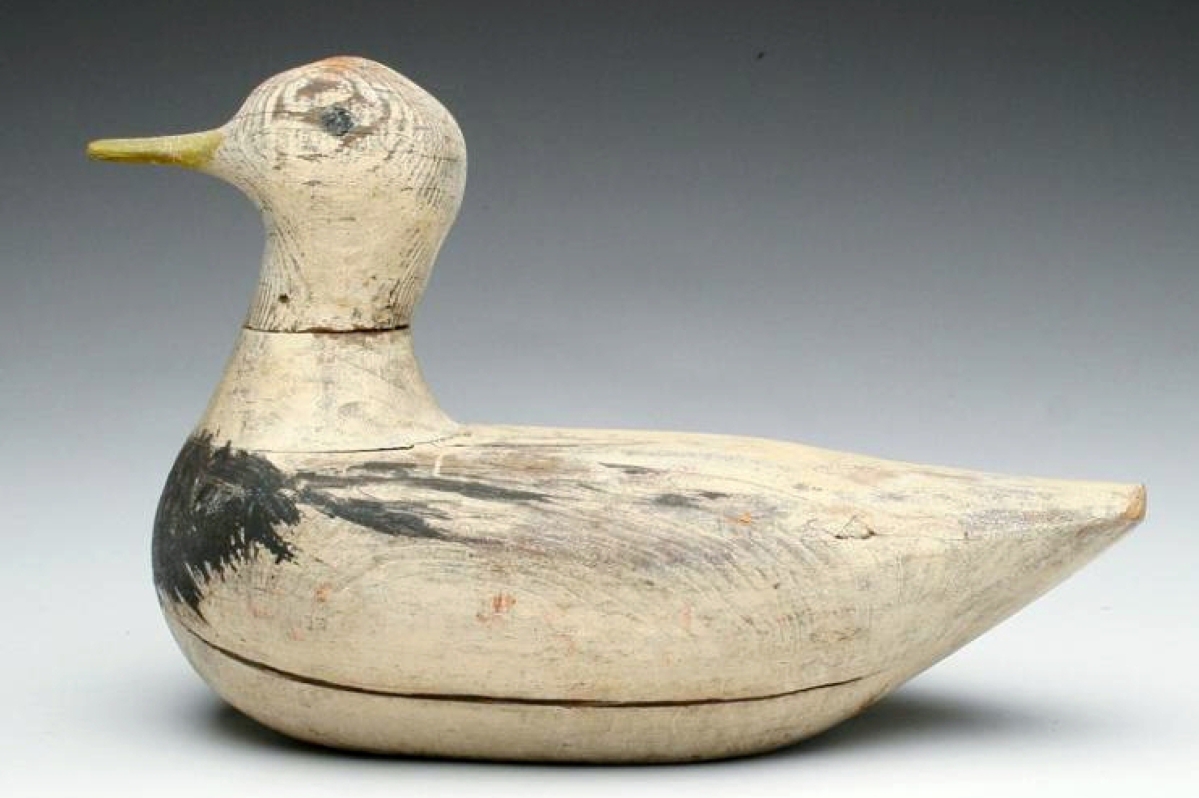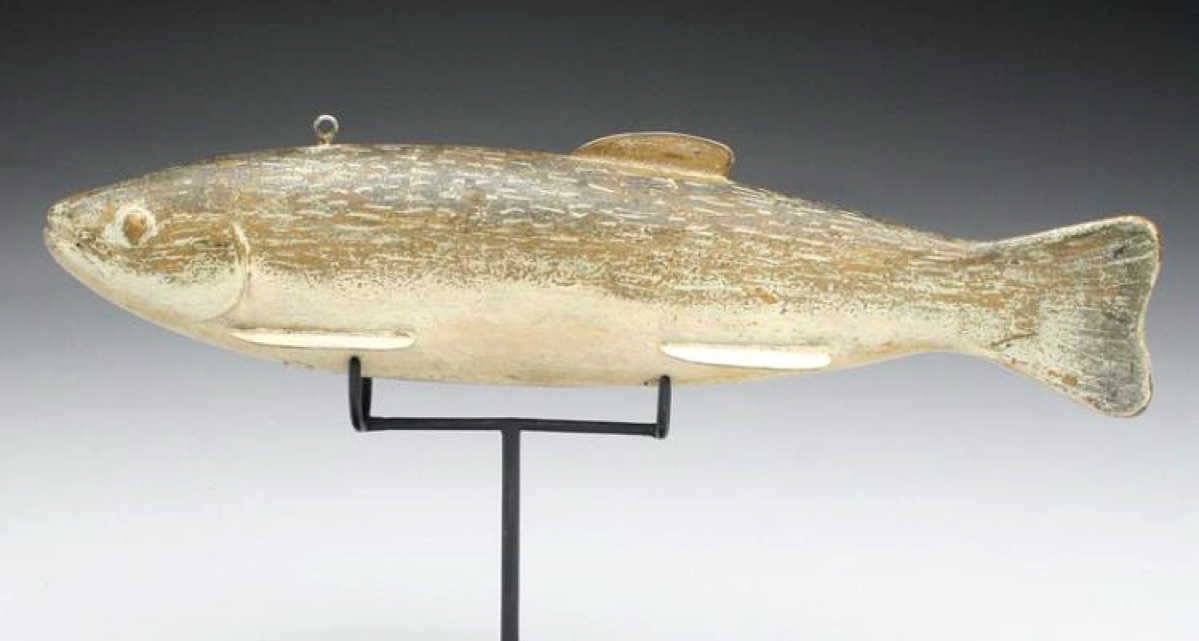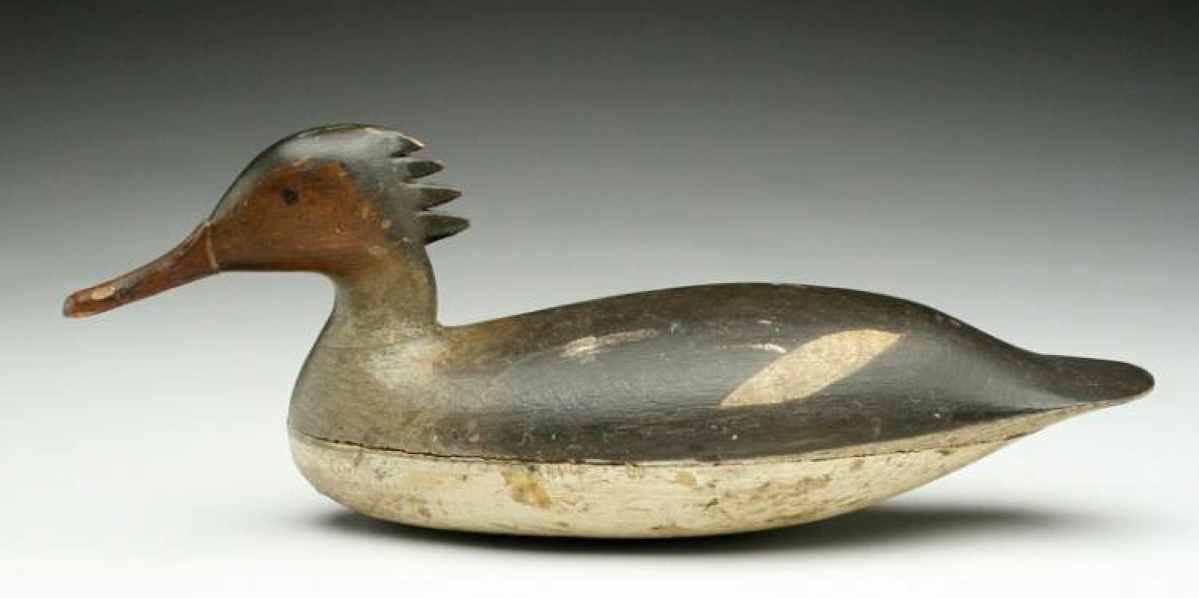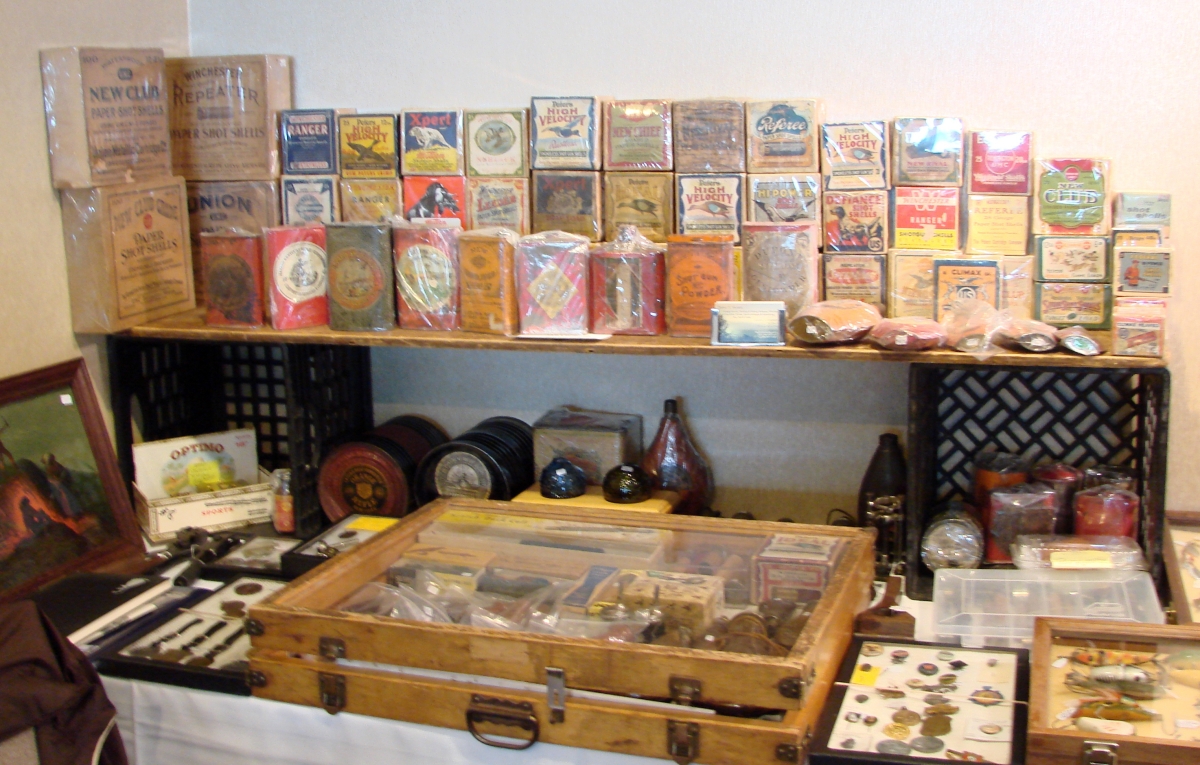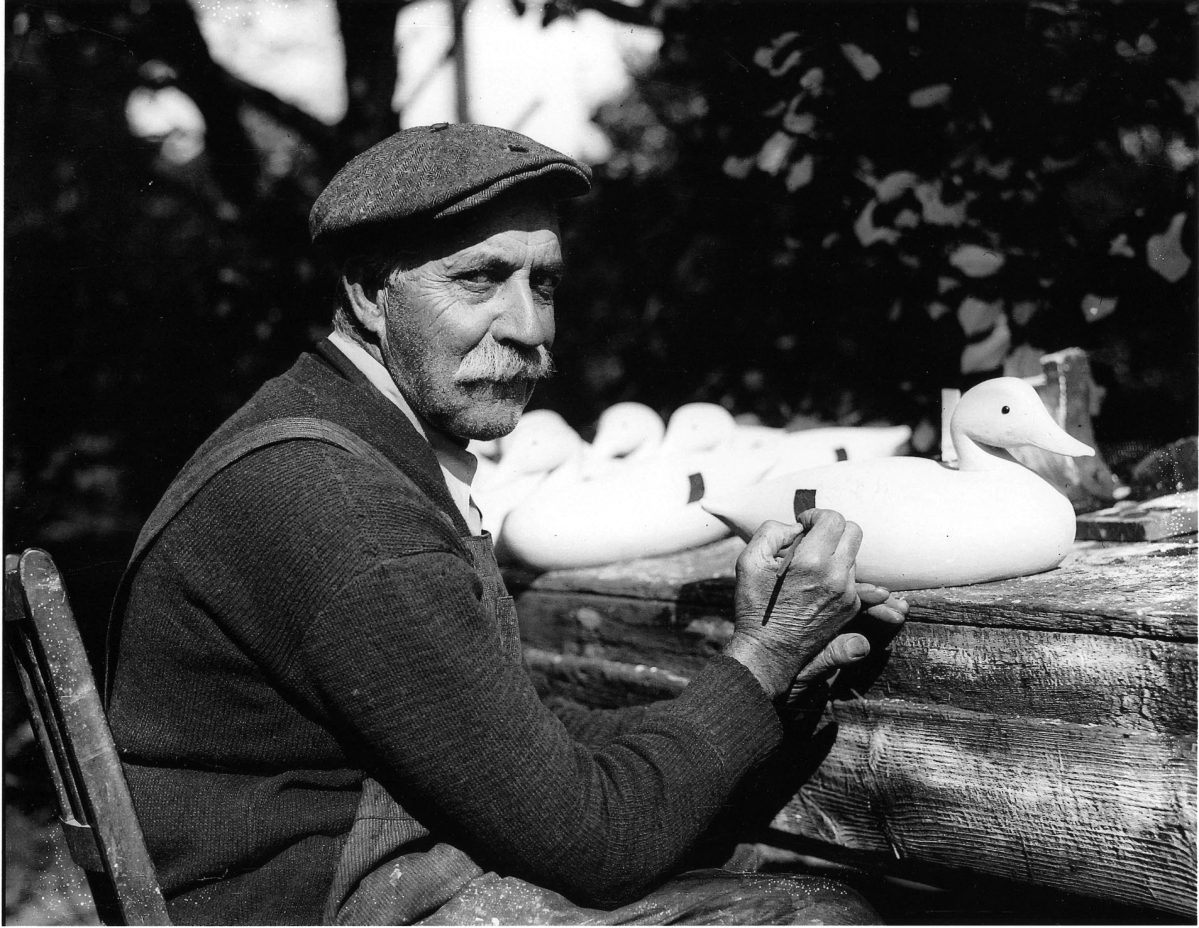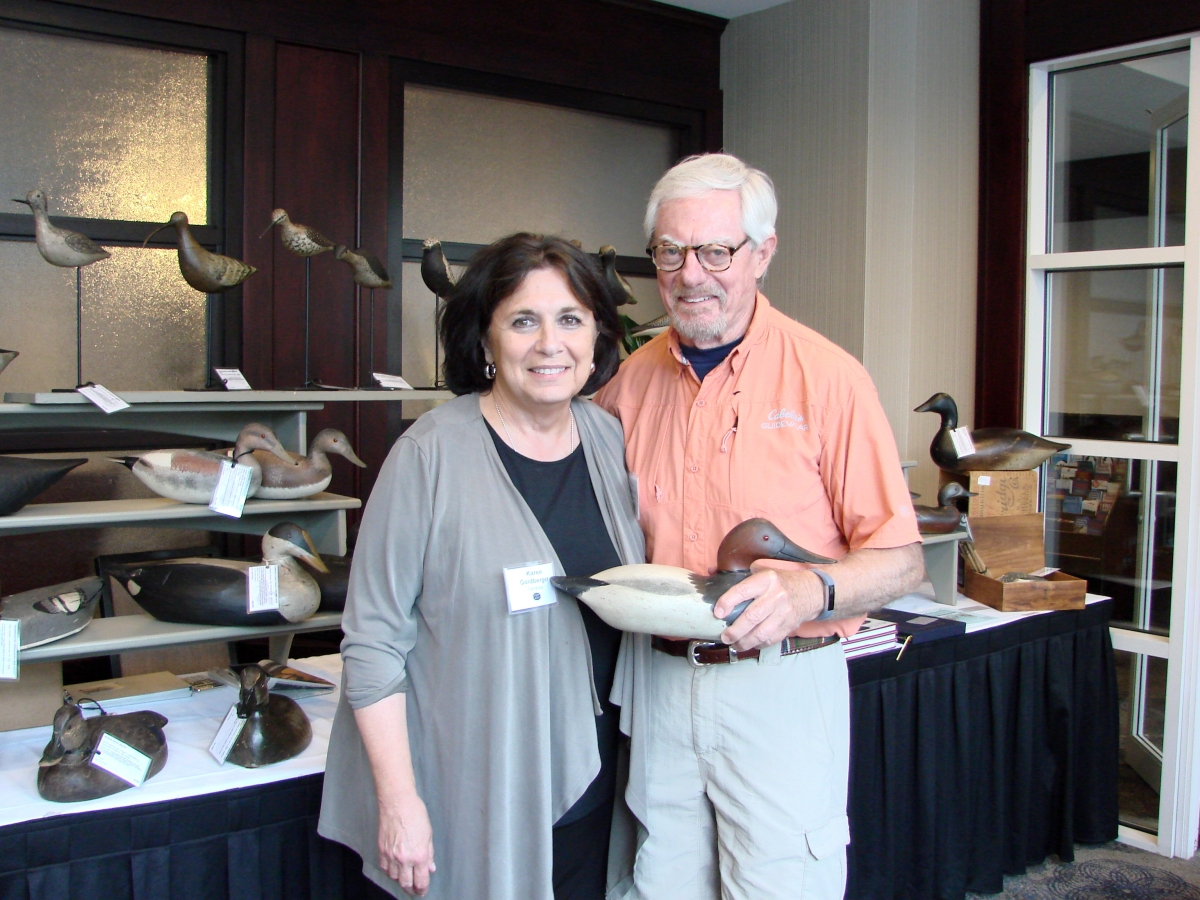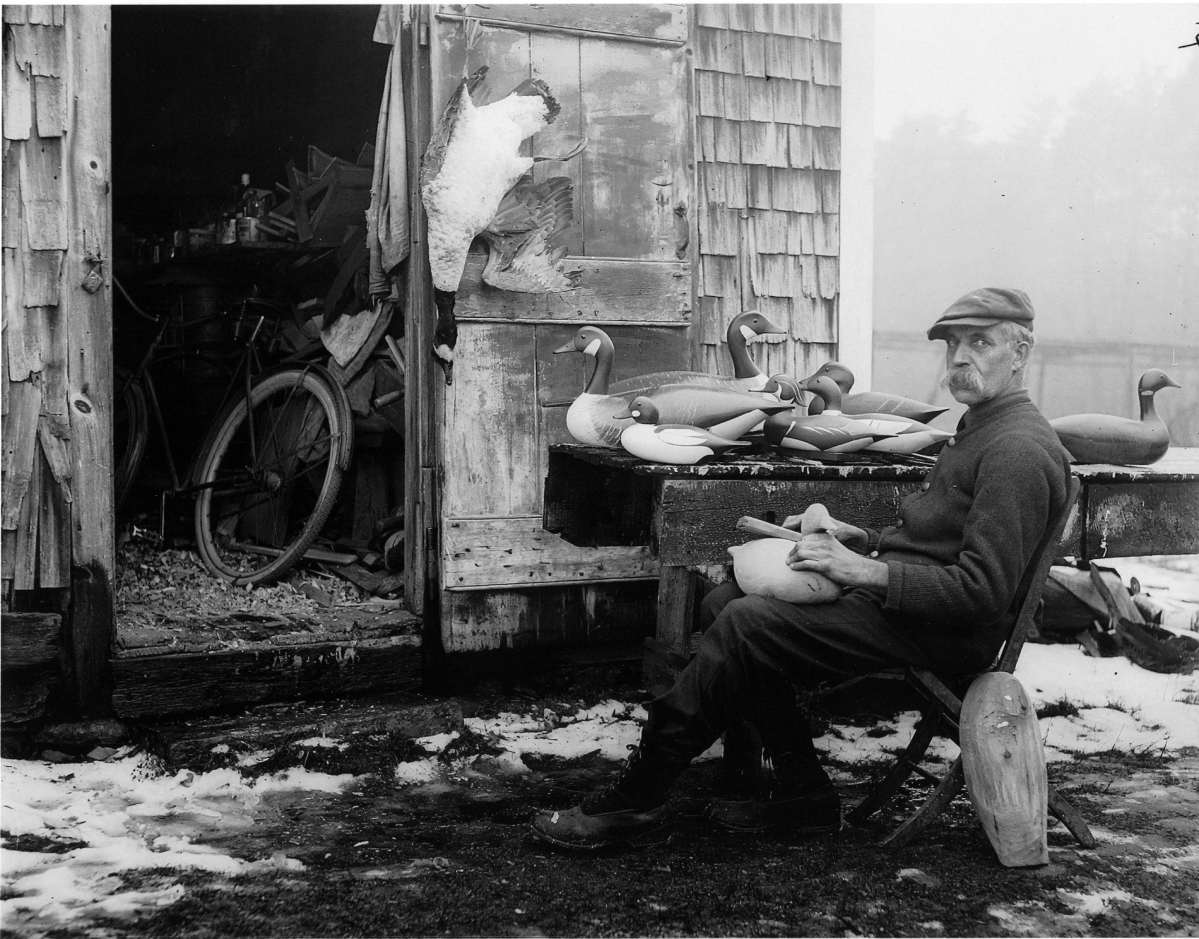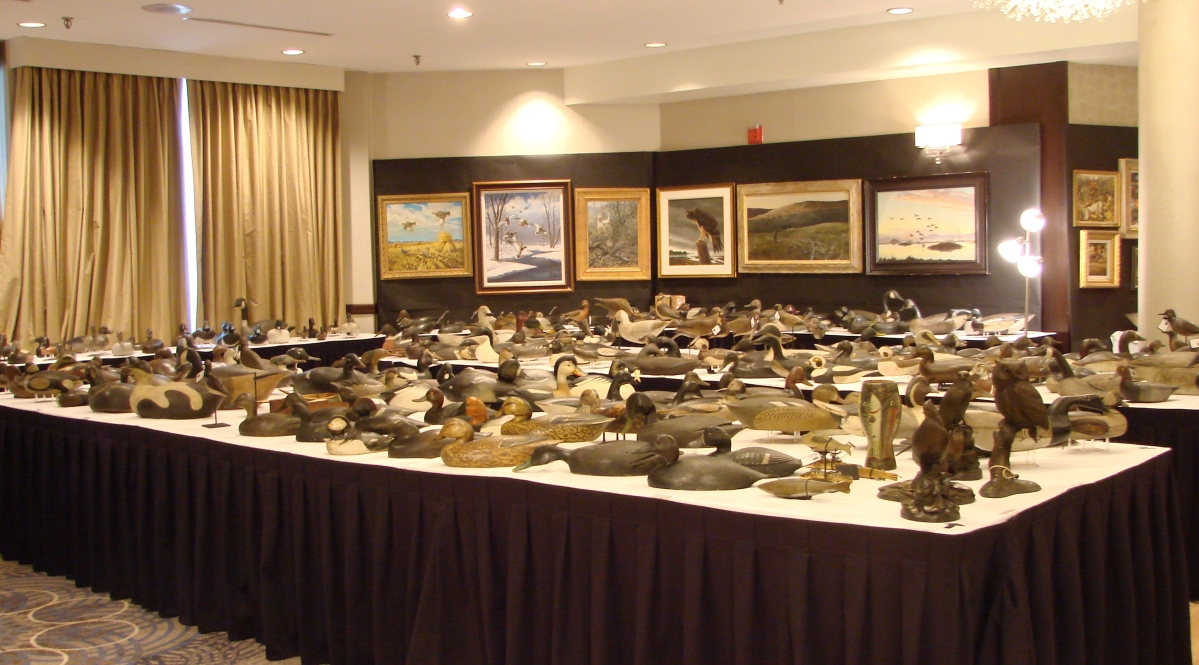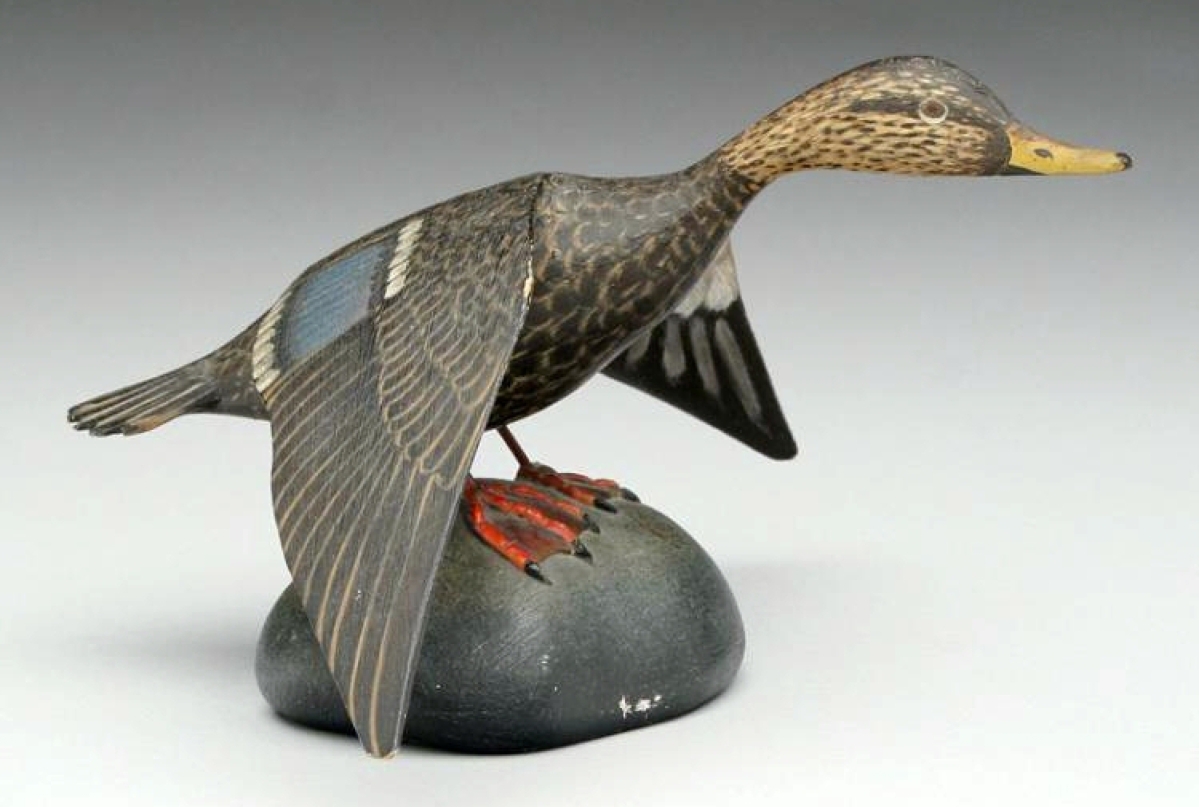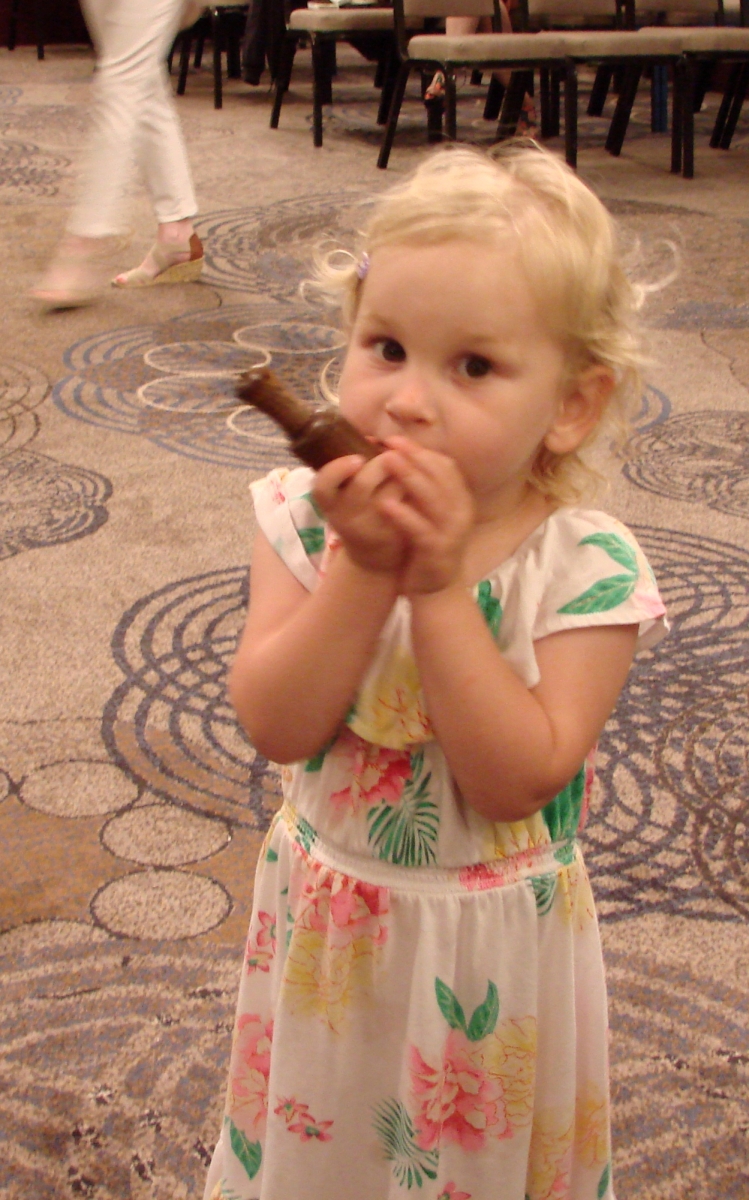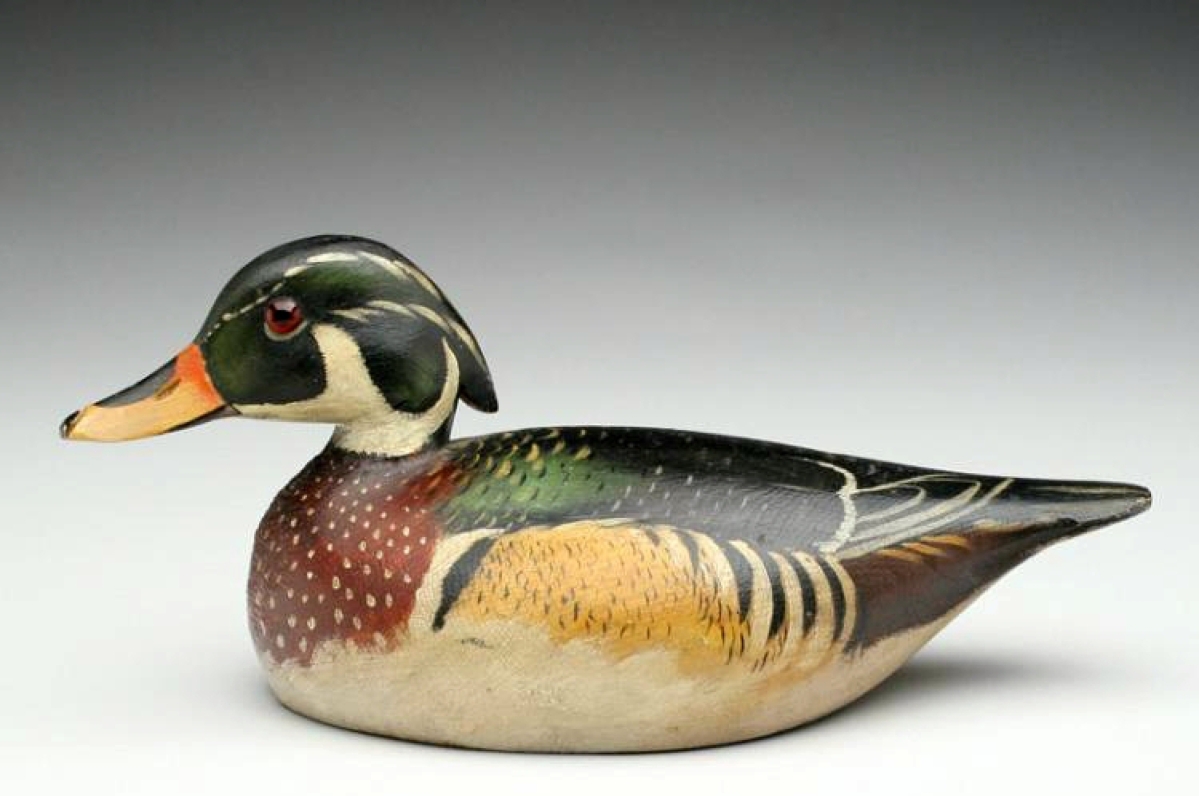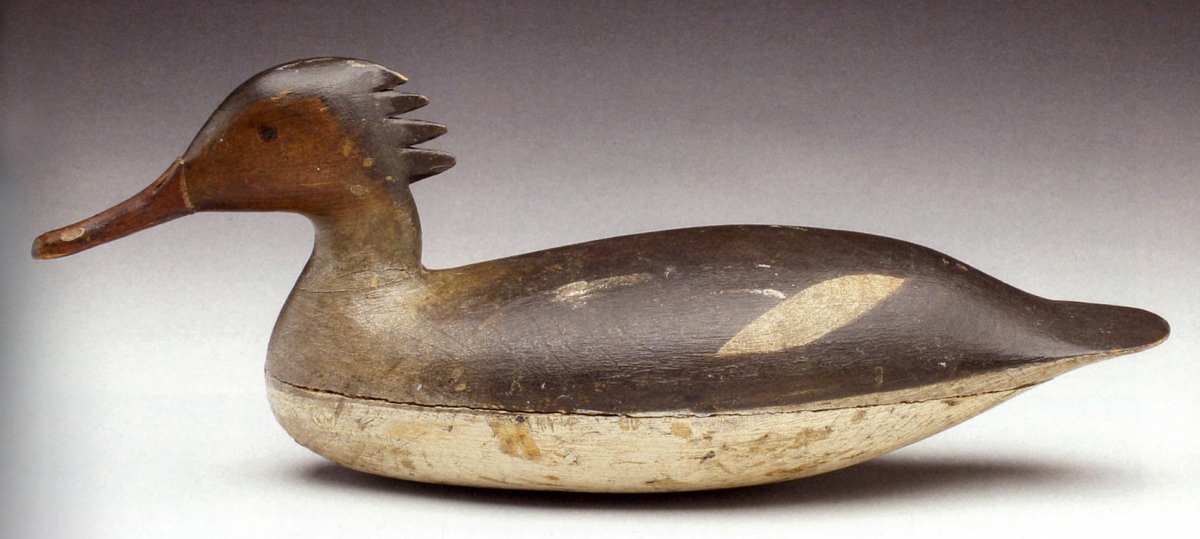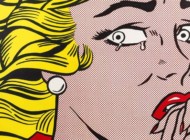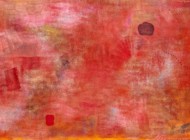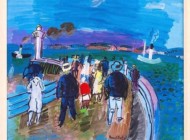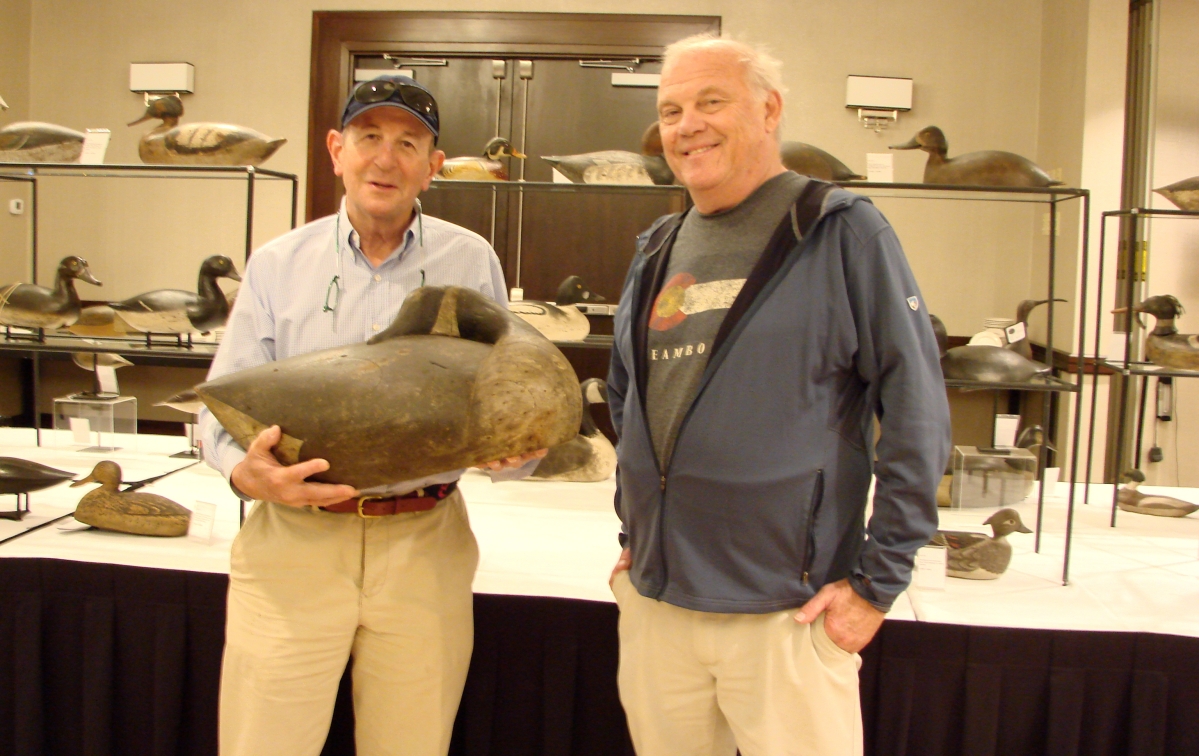
Gary Guyette with Maryland collector Don Kirson, who is holding the unique Safford goose that sold
for $517,500.
Review and Onsite Photos by Rick Russack, Catalog Photos Courtesy Guyette & Deeter
PORTSMOUTH, N.H. – A unique sleeping Canada goose decoy by Charles Safford led the Guyette & Deeter decoy auction July 25-26. It was a strong sale, 94 percent sold, with 28 decoys bringing more than $10,000 and a gross of $2.25 million. There were decoys for every pocketbook, with dozens selling for well under $1,000.
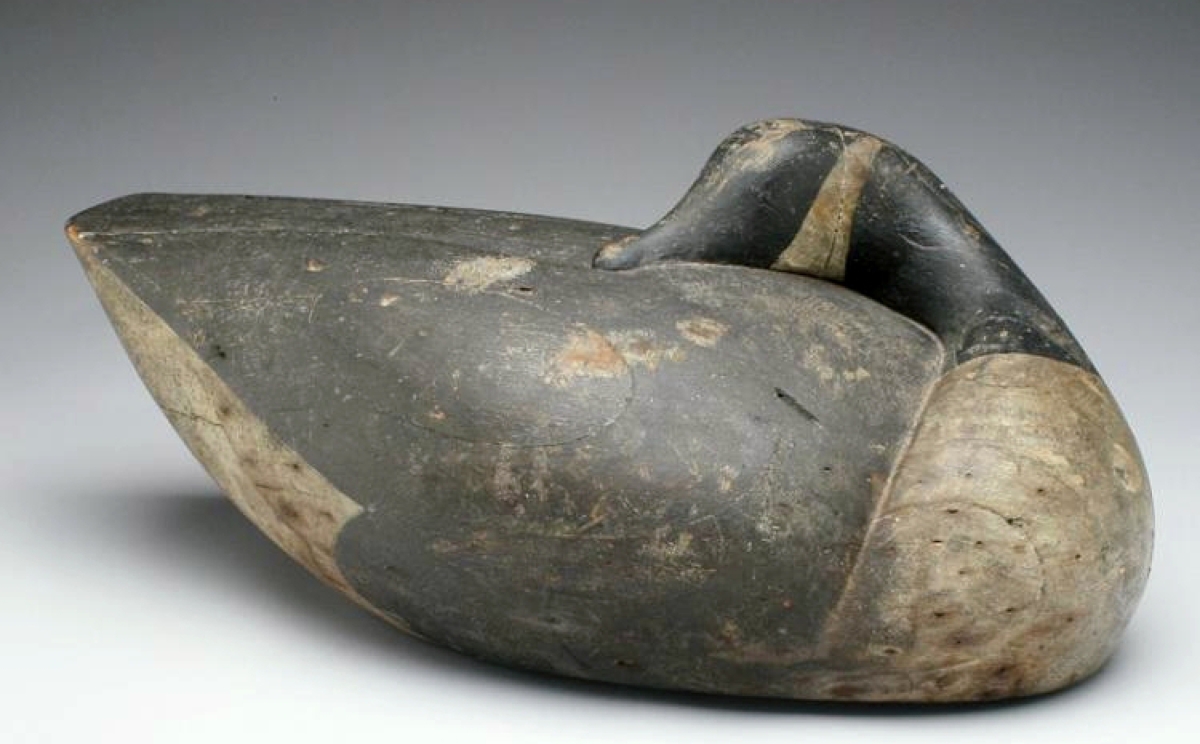
The star of the auction was this unique sleeping goose by Newburyport carver Charlie Safford. It was expected to do well and did, realizing $517,500, the tenth highest price for a decoy at auction. The quality was outstanding, the pose unique for Safford and the laminated type of construction was also unique. It was bought by Arthur Liverant, who was on the phone with his client as the bidding progressed. The decoy came from the collection of Cap Vinal, who also consigned several other outstanding decoys.
Crossing the block were outstanding factory decoys and birds carved by Elmer Crowell, Joe Lincoln, Harry Shourds and dozens of others. There were shorebirds, ducks, geese, miniatures, decorative carvings, sporting art and other items of sporting interest. Decoys from several regions were included: New England, New York, Michigan, Virginia, New Jersey, the Midwest and more.
Provenance of many birds included several of the major collections dispersed over the last 40 years. A portion of the definitive Peter Brown collection of Canadian decoys was included in the sale. About 100 buyers were in the room as auctioneer Jim Julia got the fast-paced sale underway. There were numerous absentee bids, several phone lines were in use and internet bidding was available.
Prior to the July 24 preview, about 25 dealers participated in a 50-table decoy show, which continued throughout the sale.
The star of the auction, finishing at $517,500, was the laminated, sleeping Canada goose decoy made by Charles Safford (1887-1957), who worked on Plum Island, off the coast of Newburyport, Mass. The decoy, with its original surface, is unique on two counts. According to Robert Shaw, former curator of the Shelburne Museum, “Its head is turned back laterally so the tip of the bill rests against the carved inside edge of its right wing. True sleepers, such as this one, with heads that rest on, not arch over, the back of their bodies are among the rarest of all decoy forms.”
It is the only sleeper Safford made. It is also unique in the method of its laminated construction; it is made of 17 pieces of wood. In the words of John Deeter, “It’s like a jigsaw puzzle. I’ve never seen anything like it. There are other laminated decoys, but they are glued together to achieve the desired thickness and then carved down to shape. This one is laminated in such a way as to use the grains of the pieces of wood to reduce the likelihood of it splitting, which is often a concern with large decoys.” After the sale, Deeter said, “It was the tenth highest auction price for a decoy.”
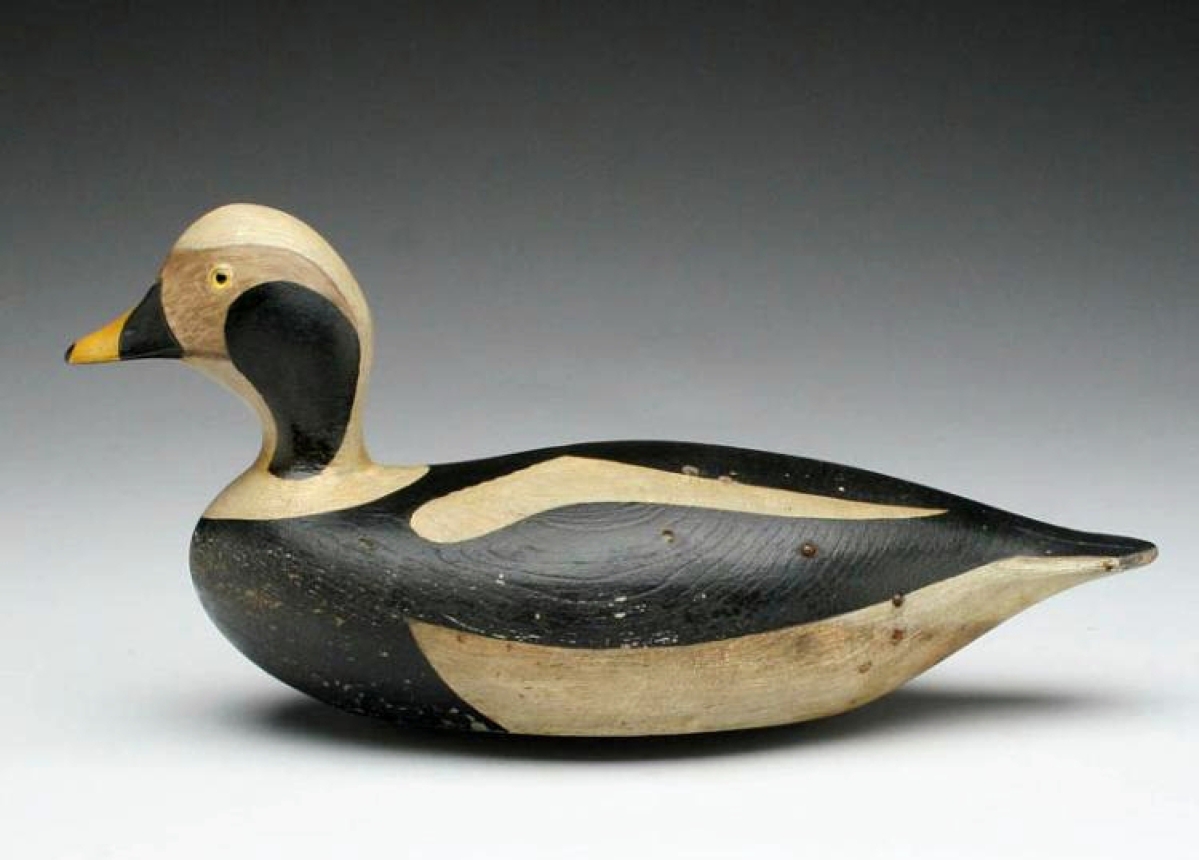
There were some important Joe Lincoln decoys. Leading the group was this rare old-squaw drake with original paint, done in the first quarter of the Twentieth Century. It was from the Cap Vinal collection, illustrated in his book on Lincoln and two other decoy books. It brought $143,750, well over the estimate.
The decoy was bought by Arthur Liverant, who was in the room and on the phone with his client. Although he has bought other decoys, Liverant was unknown to nearly all the “decoy people” in the room. At the request of his client, he carefully examined the decoy before the sale. Deeter said, “It was really an education to go over that bird with a furniture expert like that. I learned things about the way the bird was designed and put together that I would never have known if it weren’t for the time with Arthur.” Liverant later said, “It is an exceptional piece of sculpture. The maker was well versed in the movement of wood.” Some of that skill may be attributable to the fact that Safford was also a cabinetmaker and boat builder, and undoubtedly had an understanding of woods.
While discussing the purchase with Liverant, we were joined by a man from Newburyport, who said he was related to Safford. “I was having lunch the other day in Newburyport and saw an article about the upcoming sale of this decoy in a local paper. I couldn’t believe what I was reading. It was Great-Uncle Charlie’s decoy. No one in the family had any idea of the value of his decoys. When I told other family members about the article, they almost didn’t believe me. I had to come and see it for myself.” When asked if other family members had any of Safford’s decoys, he replied, “No. The day after Uncle Charlie died, his studio was broken into and lots of stuff was stolen.”
The Safford goose was consigned by Cap Vinal, a well known, very discriminating, New England collector who has been collecting for years. He is an expert on Joe Lincoln and in 2002 wrote and published, in an edition of 1,000 copies, Joseph W. Lincoln: Accord, Massachusetts, 1/26/1859-2/16/1938. He also consigned some exceptional Lincoln decoys, one of which brought the second highest price of the sale. It was an old-squaw drake, bringing $143,750, and another was a very rare greenwing teal drake, which sold for $74,750.
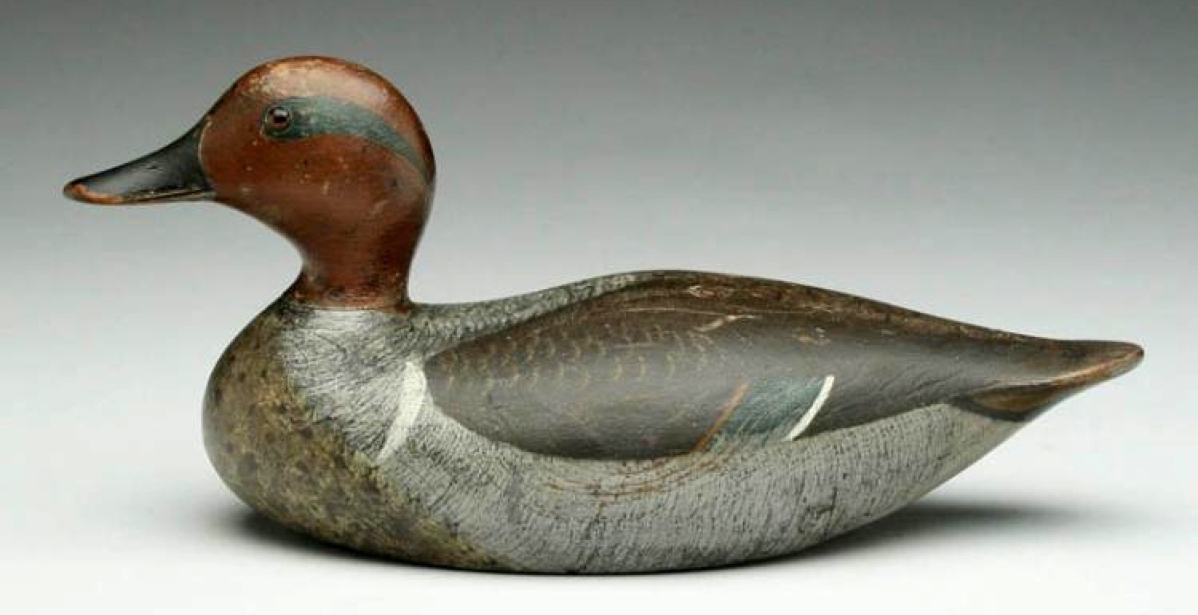
Also from the Cap Vinal collection, and pictured in his book on Lincoln and in three other books, this rare greenwing teal drake with original paint sold for $74,750. It had been in the McCleery collection, sold in 2000 at Sotheby’s, and it had been in the William J. Mackey collection that Richard Bourne sold in 1973. Some old overpaint had been professionally removed.
Both are rare because these breeds of ducks responded to a variety of decoys, so few decoys were made of these specific breeds. The teal is one of only two teal decoys by known makers and may be the only one Lincoln ever made. The teal decoy had been published in several books about decoys and appeared on the 2003 Massachusetts duck stamp. The old-squaw also appeared in several books.
When asked about how much Lincoln charged for his decoys, Vinal said, “Not an easy question – there was quite a range. Could be anywhere from $1.50 to $20, depending on the type of decoy and how much work went into making them.” The vintage photographs of Joe Lincoln accompanying this article were provided by Cap Vinal.
The sale also included some rare miniatures by Lincoln. Joe Ellis, in Birds in Wood and Paint, has suggested that Lincoln may have been the first of the decoy carvers to produce miniatures, and that Elmer Crowell started making his after visiting Lincoln’s workshop in 1904. Lincoln’s miniatures are practically exact copies of his full size decoys – he never did “decorative” carvings for the tourist trade. A pair of miniature goldeneye ducks brought the top price of the group, finishing at $5,750, followed by a miniature pintail hen, which ended up at $3,450.
There were a number of miniatures by other carvers, including several by Elmer Crowell. Topping this group of Crowells was a finely painted flying black duck, with an 8-inch wingspread, which had his oval stamp and sold for $15,525. A scoter hen and drake, with traces of Crowell’s round ink stamp, finished at $4,600 while a rare miniature eider drake, identified on the underside, earned $3,738. Other Crowell miniatures ranged from $1,035 to $2,588.
Full-sized decorative carvings by Crowell did quite well, leading off the second day of the sale. One of the featured items was an extremely rare yellowlegs with both wings up in a landing pose. Superbly painted, with Crowell’s oval brand under the base, it achieved $47,150 from a phone bidder. A preening greater yellowlegs with detailed feather carving and a metal feather in its beak reached $28,750. A decorative snipe, with dropped wings and detailed feather painting, realized $20,700.
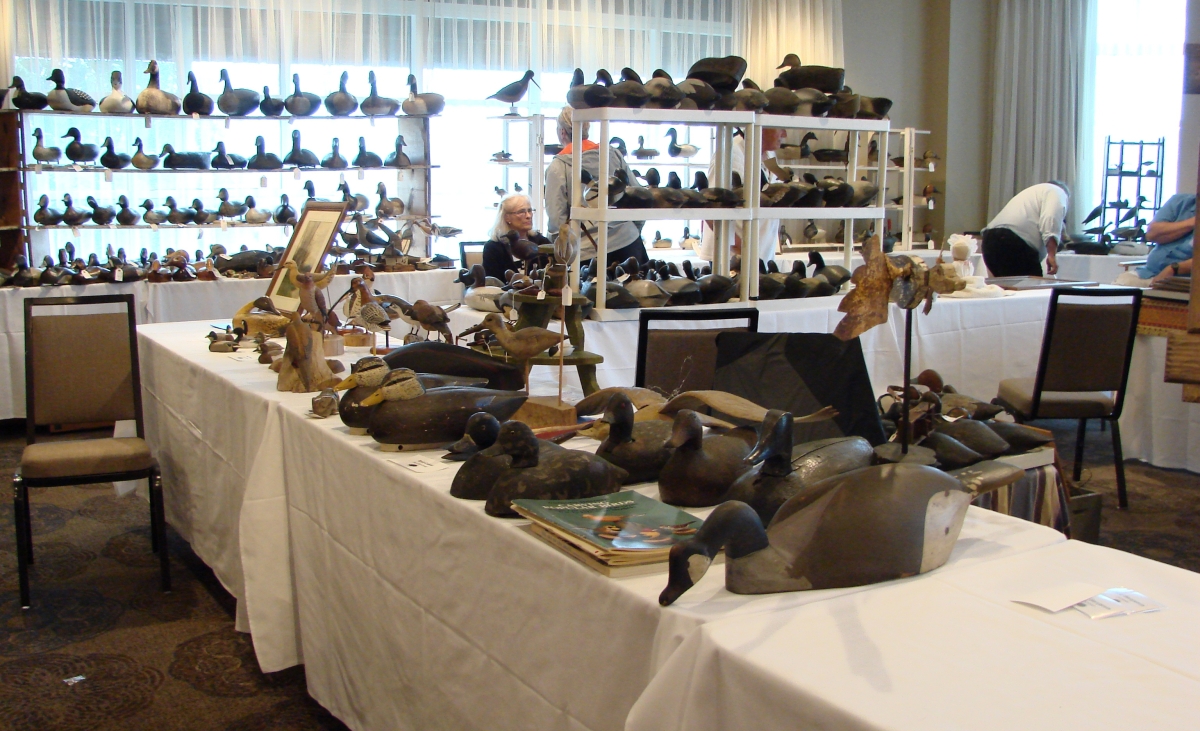
About 25 dealers set up at the decoy show that ran during the auction preview and continued while the auction was running. The cost of renting tables is nominal and several dealers said they had sold well. The Goldbergers sold decoys and Ron Bassin, Bird in Hand Antiques, sold a grasshopper weathervane and other things. Marine arts specialist Andrew Jacobson was shopping the show and said, “You never know what else may turn up.”
One of the finest and most comprehensive collection of Canadian decoys was assembled by Peter Brown. Brown recently donated 1,000 decoys, appraised at $1.5 million, to Decoys Unlimited Canada, a nonprofit organization dedicated to the conservation of wetlands and upland habitats for waterfowl. Guyette & Deeter will sell the majority of these decoys in a series of auctions and the first group was included in this sale. From that collection, a pair of hollow-carved bluewing teals, made by Ivar Fernlund, Ontario, finished at $31,050. A pair of circa 1900 mergansers by D.K. Nichol, Ontario, realized $4,600 and a circa 1930 redhead drake by Alain MacDonald, Quebec, with an open bill, turned head and finely detailed, layered feather carving, finished at $8,050. It was said to be one of only two known examples.
Some of the many other highlights from the auction include a rare pintail drake with original paint by Joe Lincoln that earned $10,925 and a group by Maine lighthouse keeper Gus Wilson that featured a large rocking head merganser, which brought $6,325. A preening scoter by Wilson, with an inlet head and relief wing carving, seemed reasonable, going out at $2,875.
Several factory birds were sold, including a pair of Mason premier grade mallards, with extra fine paint detail, earning $10,350. A rare black bellied plover by William Bowman, late Nineteenth Century, one of several Long Island shore birds, went for $12,650. There are some collectors who believe that Bowman birds were actually made by C.S. Bunn.
Accessories, such as duck calls and shot boxes, were also popular. Four calls by Bill Clifford were topped by a laminated example made of five kinds of wood, which finished at $8,625. A Winchester Rival, 100-count, paper shell box, for 12 gauge shells, earned $3,450. Shang Wheeler, Stratford, Conn., is well known as a decoy carver, but not so well known as an artist. His oil on canvas painting of two goldeneye ducks landing on a lake sold for $9,200. It was inscribed as a wedding gift, and dated 1946.
Jon Deeter was asked what the company is doing to attract new collectors. “For some time now, we’ve been running weekly online auctions of decoys at www.decoysforsale.com. The decoys we’re selling there carry the same guarantee as the birds we sell at auctions like this one, so newer collectors can feel comfortable about what they’re buying. Most of the listings are for birds estimated at under $1,000 and we know that buyers who have started with us through the online auctions are also participating in the regular cataloged sales.” Commenting on the sale, he said, “Gary and I were quite pleased with this sale. We had great stuff and the buyers stepped up. Prices have recovered nicely from the slump of a few years ago and the number of new buyers is very encouraging.”
All prices reported include the buyer’s premium.
The auction catalogs are particularly well illustrated and contain a wealth of detail and information on the carvers. Guyette & Deeter also sell reference books on decoy collecting, as does Russ Goldberger, www.rjgantiques.com.
For additional information, www.guyetteanddeeter.com, 410-745-0485 or 440-543-1416.

